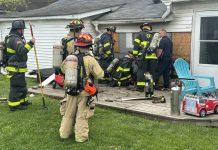A movement that began in protests against alleged national police injustice has morphed into a more permanent group advocating racial harmony, understanding and fairness.
The Black Lives Matter of Columbus chapter, awaiting approval by the national organization, aims to affirm equality and justice for blacks across a wide spectrum of society — and become a tool for racial education and unity.
The national group describes its work as “a call to action and a response to the virulent anti-black racism that permeates our society,” according to the national website at blacklivesmatter.com.
The local chapter of 25 to 30 participants of different races established its roots July 7 with Columbus native Brittany King’s hurriedly organized protest over the white officer killings of three black men in separate incidents across the country. The two-and-a-half-hour gathering at the high-traffic corner of Second and Washington streets downtown received attention from motorists passing by.
[sc:text-divider text-divider-title=”Story continues below gallery” ]
“At the original event, I was thinking more in terms of a moment of protest. Then, I thought we might keep this going and try to connect with other cities,” said King, chapter organizer and chairwoman.
The 27-year-old originally participated in an IUPUC peaceful student protest over the killing of a black man, Michael Brown, in Ferguson, Missouri, in August 2014 by a white police officer. She also participated a few months later in what was labeled a peaceful “die-in” in front of the library in 2014 at the Columbus Learning Center.
Student protestors at that event lay passively on the floor as if they were dead.
That was to protest the death of Eric Garner, who died after a New York City police officer placed him in a choke hold while Garner was being arrested on the suspicion of selling single cigarettes from packs without tax stamps. While Garner was held face-down on the ground, video of the incident shows him repeatedly telling officers he couldn’t breathe.
“We want to be careful to let people know that we’re not anti-police, not anti-white, not pro-violence, and we’re definitely not terrorists,” King said. “But we definitely are pro-justice, anti-police-brutality and against systematic racism.”
King said she has faced elements of racism her whole life. Since the chapter began, people posting on social media have occasionally used racial slurs in private messages to the group, or epithets in postings on the group’s Facebook page of Black Lives Matter of Columbus.
King said she believes such expressions reflect the work that still must be done with race relations.
In the local Black Lives Matter chapter’s nearly four-month existence, besides the protest, its biggest event was the Oct. 7 showing of the documentary, “The Color of Fear,” followed by a discussion at the Columbus Learning Center before more than 75 people, including Mayor Jim Lienhoop. The film highlights the pain of racism in America.
During the discussion portion of the event, Black Lives Matter partnered with a different local chapter of a national organization, Showing Up for Racial Justice, although the two groups are not directly connected.
Sometime in the future, King ideally wants to organize a public meeting between Columbus police officers and young black men in the community to help ease any potential uneasiness or discomfort between the two groups. She said the more the two groups know about each other, the better their relationship can be.
“What if the police officers in Baton Rouge, Louisiana, actually already knew a little bit about Alton Sterling before that situation (in which he was shot and killed in July)?” asked King.
Columbus Police Chief Jon Rohde, who spoke briefly with King after a police event this summer, said his officers “are responsive to citizen needs and are committed to providing professional service that protects lives, property and personal liberties, while developing community partnerships and welcoming the diversity of our citizens.”
He added that the department still submits to third-party oversight both of its accrediting agencies — the Commission on Accreditation for Law Enforcement and the Indiana Law Enforcement Accreditation Commission. He says that oversight is among the strongest steps to maintain public trust with all residents, whatever their race, background or belief.
Lienhoop, who first spoke with King during her and her friends’ July 7 protest, said he found “The Color of Fear” gathering and the comments it triggered important and interesting.
“Anything that enhances dialogue and understanding is worthwhile,” Lienhoop said. “My thinking is that various forms of dialogue and discussion always are important to us as a community.
“There may come a time when I might ask them to listen to something I might be saying. So I feel like it’s certainly important for me to listen to them as well.”
Lienhoop mentioned that he’s heartened by Columbus residents willing to work on issues such as racial equality and harmony before problems surface. He cited Charleston, South Carolina’s unity after shootings there in June 2015 at a predominantly black church, and said many attributed that aftermath to diversity-related groundwork laid long ago.
“Relationships already had been developed,” Lienhoop said.
Jessarae Emberton, King’s co-organizer for the local chapter, is white, and has had black friends since her childhood. She said she believes it’s important for local residents eventually to have and acquaintances of other races.
Emberton said at past meetings, about 30 people attended, and the majority — as many as 25 attendees — are white. But she said it’s important that the white participants allow black members to steer the group’s direction.
“They’re the ones living this (experience as a minority),” Emberton said.
Aid Ramirez, director of the Columbus Human Rights Commission, said she welcomes another avenue of input to continue to make the community more welcoming for a diverse population.
“One of the missions of the Human Rights Commission is to challenge attitudes and beliefs that serve as barriers to equality,” Ramirez said. “Using that factor in this analysis, it is my opinion that any opportunity to collaborate, share and embrace differences of self — not to mention opinion — adds value.
There’s value in exploring our differences and especially in collaborating with community partners to make the collective Columbus experience more welcoming for all.”
[sc:pullout-title pullout-title=”About Black Lives Matter of Columbus” ][sc:pullout-text-begin]
Began forming: After a downtown peaceful protest over white police killings of black men in July.
Goal: Advocating criminal justice reform reform nationally to ensure fairness to blacks; to be an educational tool about blacks and minorities; and to promote racial unity.
Current participants: 25 to 30 people, many in their 20s and 30s.
Information: Facebook page for Black Lives Matter of Columbus or [email protected].
[sc:pullout-text-end]




